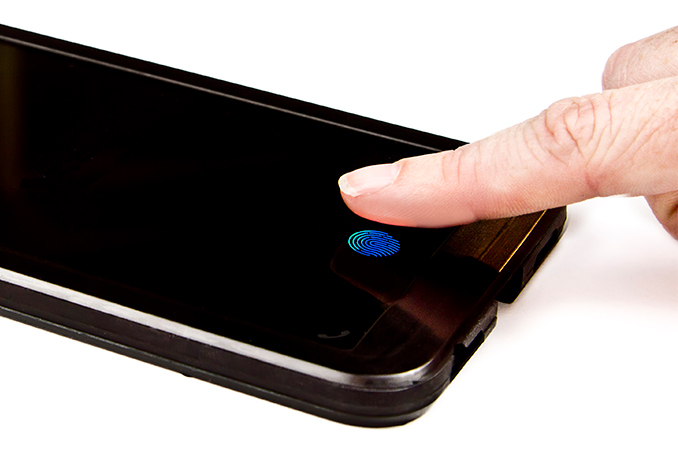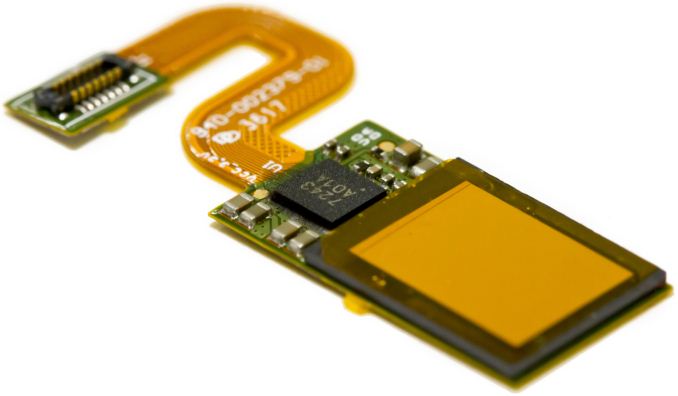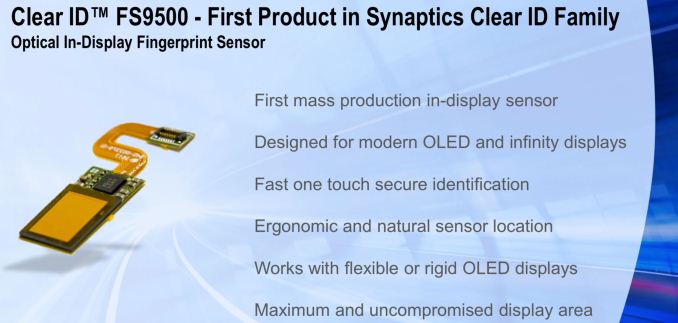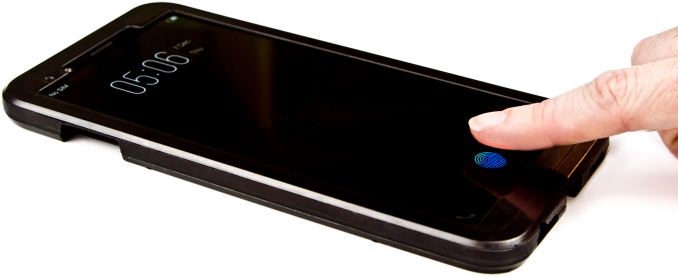Synaptics Unveils Clear ID In-Display Fingerprint Sensor for 18:9, 20:9 Smartphones
by Anton Shilov on December 14, 2017 1:00 PM EST- Posted in
- Smartphones
- Android
- Synaptics
- AMOLED
- Security
- Biometrics

Synaptics this week introduced its first Clear ID FS9500 in-display optical sensor that can be installed under the surface of an OLED screen. The fingerprint reader works faster than facial recognition and can be used in any environments, including dark rooms and sunny beaches, Synaptics says. The first smartphones featuring the technology are due in Q1 2018.
Biometric authentication has become a mandated feature of every smartphone in the recent years, but integrating fingerprint sensor has become a challenge as screen-to-body ratio is growing and many front panels have no space for the reader. Some smartphone makers install fingerprint sensor on the back panels of their devices, other, like Apple, introduce facial recognition technologies that require IR and RGB sensors accompanied by appropriate processing resources. Synaptics argues that fingerprint sensors on the back are uncomfortable to use, whereas facial recognition technologies are relatively slow and can be fooled. By contrast, Synaptics’ latest Clear ID FS9500 sensor is hidden under the screen on the front and it works as fast as users come to expect from similar devices in the recent years.
The Synaptics Clear ID FS9500 fingerprint sensor is a tiny CMOS device that sits below the AMOLED display assemly and captures the reflected fingerprint between and through the OLED pixels. Synaptics said that the captured fingerprint has a very high resolution, but naturally does not quantify this claim. To make a fingerprint reflect, a part of the screen has to be lit-up, so while the device itself only uses 80 mA, the screen consumes some additional power too (Synaptics does not disclose the lowest brightness level of the display required for scanning as it depends on many factors). Meanwhile, Synaptics uses accelerometers and other sensors inside the phone to activate the sensor and turn on an appropriate area on the screen. The activation happens instantly, then it takes 0.7 seconds to scan the fingerprint, match it and grant or deny access. By contrast, Synaptics says, it takes modern smartphones about 1.4 seconds to scan a face.
The SF9500 does not support Match-In-Sensor technology, so the matching is performed by host using Synaptics’ Quantum Matcher software. It is noteworthy that the software Synaptics supplies with its sensors is quite complex. Apart from matching, the software is responsible for activating the reader and the screen whenever the phone is touched and for other things (like taking into account outside conditions that may affect minutiae). The new fingerprint sensor from Synaptics connects to host using the SPI bus. Depending on application and requirements, device manufacturer may choose to use an AES-encrypted SecureLink interface (e.g., if the SF9500 is installed into a bezel-less tablet, or a laptop display) if required.
The Clear ID FS9500 is “smart” enough to detect fingerprints in sunlight and bright conditions, take into account wet and/or cold fingers, detect spoofed fingerprints and so on. It remains to be seen how the sensor behaves when individual light-emitting pixels burn-in over time, but since Synaptics has a robust program stack supplied with its sensors, it can tweak them using software to compensate for screen degradation.
According to Synaptics, the Clear ID SF9500 sensor itself is only 0.69 mm thick and its integration does not make smartphones significantly thicker. The sensor integration process has to be performed by the screen manufacturer at a fab where display assemblies are made and Synaptics is working with appropriate makers. The process is not very complex, so it does not make final devices considerably more expensive, says the developer.
Synaptics initiated mass production of its Clear ID FS9500 sensors this month and will start their commercial shipments in the coming weeks. The company says that the first smartphone that uses the in-display fingerprint reader will be available in early 2018. Synaptics naturally does not disclose the manufacturer of the device, but only says that it is one of the Top 5 smartphone suppliers. Meanwhile, since the FS9500 sensor only works with OLED screens, this big producer of the smartphones has to have access to the AMOLED technology. Synaptics plans to showcase the handset at CES, but it is unclear whether the device will have been announced by that time, or Synaptics will show it camouflaged. Anyway, the first smartphone featuring the FS9500 is incoming and it will be available soon.
Related Reading:
Source: Synaptics














39 Comments
View All Comments
A5 - Thursday, December 14, 2017 - link
It has to be Samsung, right?nerd1 - Thursday, December 14, 2017 - link
It would be quite fun to see apple ditch the "notch" and facial detection this time....peevee - Thursday, December 14, 2017 - link
Both can be made available. It is not like Apple's phones are too cheap for that.jjj - Thursday, December 14, 2017 - link
With facial recognition you can't have 100% display. The front cam can be tucked behind the display and pop up when you open the camera app to enable 100% screen to body ratio but with facial recognition you can't do that (not practical). Facial recognition is also less than ideal for folks that cover their faces on a regular basis like wearing a burqa, surgical masks in Japan or pollution masks in China, some types of glasses, some types of winter outfits.Ofc a really fast fingerprint scanner in the power button to enable a single click wake and unlock would maybe be best solution and certainly much cheaper.
SunnyNW - Thursday, December 14, 2017 - link
Completely agree with your last point concerning the sensor being apart of the power button, even though I haven't done much research into it. I know Sony had a similar solution introduced years ago not sure why it hasn't seen widespread adoption; maybe too big of a button, slow activation time, too power hungry, low accuracy...?jjj - Thursday, December 14, 2017 - link
No idea why, maybe it's just Sony's minimal influence and poor product design from others, maybe it's the size of the button.This is about convenience so as long as we need the power button to turn the display on, integrating the two seems ideal. In theory, facial recognition could also turn the display on but it's not quite good enough for that yet and there won't be room for it on the front anyway. By the time 3D sensing can be integrated in the display stack, smartphones will be replaced by glasses so it's really less than ideal to bother with it, it's simply too late for it.
Samus - Thursday, December 14, 2017 - link
Apple could adapt this concept to FaceID, and have that array of sensors under the screen. Maybe even the camera. The trick is going to be to make the screen translucent from the bottom and top layer.jjj - Friday, December 15, 2017 - link
With the camera, likely the biggest problem are the optics, you can't put it in the display as long as you have optics so we would need image sensors that do not require traditional optics. In any case, considering where they are today ,it would take quite a few years to evolve it that way and by then, glasses should become more important. With glasses, 3D depth sensors are fundamental for gesture recognition, virtual keyboards, 3D mapping and so on. With glasses the biggest problem would be power and heat, no need for display integration but active illumination (the IR and dot projector) is maybe less than ideal and they would have to find the right balance between active and passive illumination.jjj - Friday, December 15, 2017 - link
PS: Apple did buy InVisage and likely the first application they will be targeting with the InVisage image sensors is IR and not the main cameras.jjj - Thursday, December 14, 2017 - link
No it is not Samsung for sure.Synaptics has made it clear months ago that this first device is from a phone maker from China And they also made it rather clear that they don't have the fingerprint sensor in the Galaxy S9.